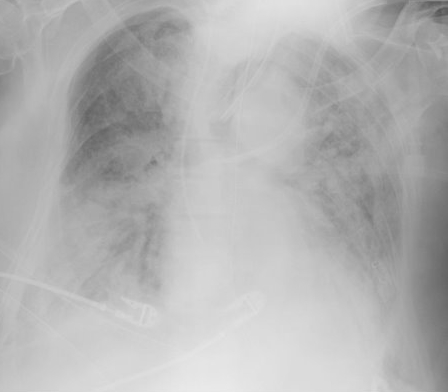Category: Critical Care
Posted: 7/30/2013 by Haney Mallemat, MD
Click here to contact Haney Mallemat, MD
Elderly patient who originally presented for severe pancreatitis now intubated for worsening hypoxemia. CXR is shown below, what's the diagnosis?

Acute Respiratory Distress Syndrome (ARDS)
Acute Respiratory Distress Syndrome (ARDS) is defined as hypoxemia secondary to increased pulmonary capillary permeability and non-hydrostatic (i.e., non-cardiogenic) leakage of fluid into the interstitial lung tissue and alveoli. Lung radiographs diffuse and symmetric infiltrates (see below)
ARDS may occur secondary to a primary (or pulmonary) insult (e.g., aspiration, pneumonia) or secondary (or systemic) insult (e.g., pancreatitis, trauma, etc.)
The newest classification system for ARDS no longer includes the previously known category of acute lung injury; there are three categories of ARDS determined by the PaO2 (on ABG) divided by administered FiO2 (as a fraction of 100%):
A number of interventions have been demonstrated to improve outcomes for patients with ARDS:
Follow me on Twitter (@criticalcarenow) or on Google+ (+criticalcarenow)
